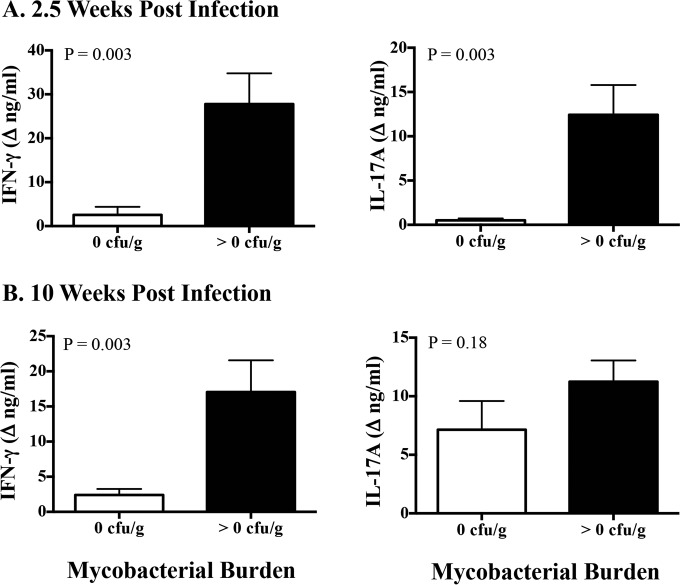FIG 6.
Association of ESAT-6:CFP10-specific IFN-γ and IL-17A responses with mycobacterial burdens in the 2014 vaccine efficacy study. Treatment groups included nonvaccinated animals, BCG-vaccinated animals, and animals vaccinated with BCG mutants (i.e., BCG Δfdr8, BCG ΔleuCD Δpks16, BCG ΔmetA, and BCG ΔmmaA4). Virulent M. bovis strain 10-7428 was administered by aerosol to all calves 3.5 months after vaccination, and calves were euthanized 4.5 months after M. bovis challenge (Table 1). Whole blood from all calves was collected into heparinized tubes at 2.5 and 10 weeks after challenge and stimulated with 1 μg/ml rESAT-6:CFP10 or medium alone (no stimulation) for 16 h at 39°C, and plasma was harvested for IFN-γ and IL-17A analyses using commercial ELISA kits (Bovigam [Prionics Ag] and bovine IL-17A ELISA VetSet [Kingfisher Biotech]). Mycobacterial burdens were determined by serial dilution culture of entire tracheobronchial lymph node homogenates and are presented as culture-forming units per gram of tissue. Groups were split based on mycobacterial burdens of 0 CFU/g (n = 14) or >0 CFU/g (n = 15). All 14 animals in the 0-CFU/g group were vaccinated animals. In the >0-CFU/g group, 5/15 animals were vaccinated animals and 10/15 were nonvaccinated animals. Data (mean ± SEM) are presented as IFN-γ (left) and IL-17A (right) responses (changes in nanograms per milliliter, i.e., antigen stimulation minus medium alone) to rESAT-6:CFP10 at 3 weeks after M. bovis challenge (A) and 10 weeks after M. bovis challenge (B), as related to mycobacterial burdens determined at necropsy 4.5 months after challenge. Similar results were obtained for responses to M. bovis PPD (data not shown). Student's t test P values are provided in the upper left corner of each graph.

